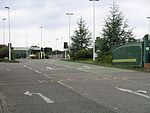The Old Hall Hotel, Coventry
Buildings and structures in CoventryGrade II listed buildings in the West Midlands (county)Hotels in Warwickshire

The Old Hall Hotel in Coundon near Coventry, England, is a building of historical significance and is Grade II listed on the English Heritage Register. It was built in about 1800 by a wealthy landowner and was called Coundon Villa and later Coundon Hall. It was the residence of several notable people until about 1947, when it was converted to a hotel. Today it is still a hotel which provides accommodation, restaurant and bar facilities.
Excerpt from the Wikipedia article The Old Hall Hotel, Coventry (License: CC BY-SA 3.0, Authors, Images).The Old Hall Hotel, Coventry
Tamworth Road, Coventry Radford
Geographical coordinates (GPS) Address Nearby Places Show on map
Geographical coordinates (GPS)
| Latitude | Longitude |
|---|---|
| N 52.44082 ° | E -1.53836 ° |
Address
The Old Hall
Tamworth Road
CV6 2JH Coventry, Radford
England, United Kingdom
Open on Google Maps






